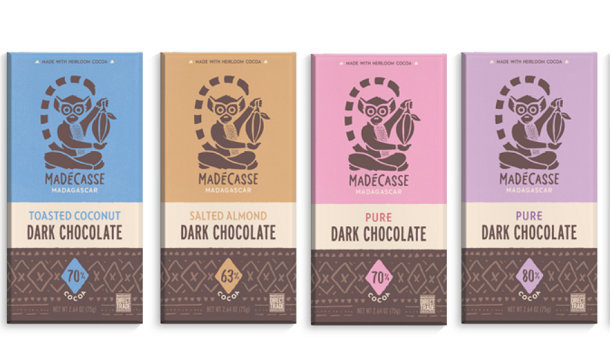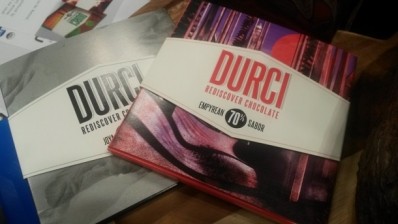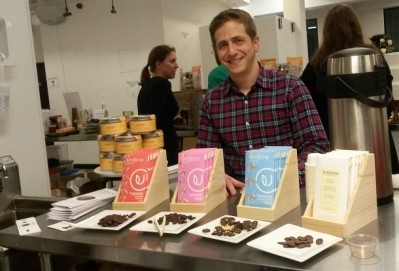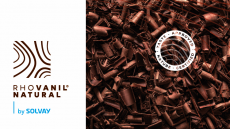Madécasse monkeys around with branding to make chocolate more memorable, accessible

“We know our name is a bit challenging for people to say,” which could stifle growth to the extent that consumers struggle with how to share the brand through word of mouth, acknowledged Sarah Shah, director of marketing Madécasse Chocolate & Vanilla. But at the same time, after eight years of investing in the name and building the brand, the company didn’t want to scrap Madécasse completely.
“We do have a following that is loyal and … because it is such a unique name we do not have to worry about copyrights and trademarks, so we decided to stick with it, but also do something more iconic and incorporate an image that can almost be used interchangeably by consumers when they talk about the chocolate,” Shah said. “We are okay if people don’t remember the name or feel uncomfortable trying to pronounce Madécasse when trying to tell someone about the chocolate as long as they have something very clear that they can reference that will help their friends find it in a store.”
That “something” is a ring-tailed lemur that will sit proudly on the top three-quarters of the chocolate bars’ front packaging in a warm dark brown that recalls the sweet and heady flavors of what is inside, Shah said.
She explained that the company knew it wanted an animal for its icon after analyzing the successful use of other animals by well established brands, such as the alligator for Lacoste and the Vineyard Vines' whale – both of which are instantly recognizable and unequivocally associated with their respective brands.
“We thought about what represents Madagascar,” which is where the company’s chocolate is sourced and mainly made, “and the first thing that came to mind was the lemur – and the ring-tailed lemur specifically with its striped tail,” Shah said.
Like the name, not all Americans will know what a ring-tailed lemur is, but Shah said awareness is growing thanks to the movie Madagascar, and even if people didn’t know the specific species, they would remember “that little monkey-thing.”
So, she said, “we decided to take a chance and make it really big and bold.”
Clear labeling simplifies shopping for time-pressed consumers
The lemur dominates the packaging, but the new wrappers leave no room for confusion by clearly declaring the contents as dark chocolate directly under the lemur and company name. In addition, the bars are color-coded based on their flavors, so that consumers can more easily recognize which bar they tried and want to buy again, Shah said.
Tucked at the bottom of a bar inside of a pattern that is “a little bit more representative of African culture,” is the percentage of cocoa in each bar – a number that Shah says consumers increasingly want to be higher, as they associate darker chocolate with more health benefits.
The new packaging is like night and day from the brand’s current packaging, which is white and features generic but boldly colored printed images of chocolate bars and cocoa pods, Shah said.
A big problem with the old packaging is that Madagascar chocolate appears in small print at the top, causing some consumers to miss altogether that the product was chocolate, Shah said.
Along with the new packaging, Madécasse will update its website and lower its price point from $4.99 currently to $3.99 – all features that the company hopes will make its product more accessible.
Heirloom beans give consumers room to explore flavors
Another way the package redesign makes the chocolate more accessible to consumers is by simplifying the descriptions of the flavors to just one or two highlights and playing up that the beans are heirloom, rather than going into detail about the tasting notes of each bar, Shah said.
“Our current packaging has the call-outs of the flavor notes or the fruity aspects, but we decided not to go with that this time and just use heirloom cocoa as the lead on the front … because we didn’t want to send people in the wrong direction given that flavor is subjective,” Shah said.
“Like wine, some people might taste smoke and some people might taste cherries, but if they didn’t then then brand did not want people think they were not good at this or that the brand was too pretentious,” she explained.
“We definitely did not want to be off-putting in any way,” she added.
Plus, the term heirloom is trendy and has “a bit of a halo around it,” so consumers are drawn too it and by extension products making the claim, Shah said.
Additional innovation on the horizon
In addition to the new packaging and website, which will launch in late September or early October, the company is exploring new flavors and formulations, Shah said.
She explained that the company recently hired a new chef trained in bean to bar chocolate to help develop recipes and flavors, which the team is “really excited about.”
















